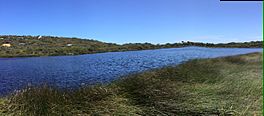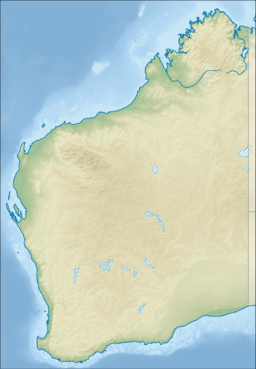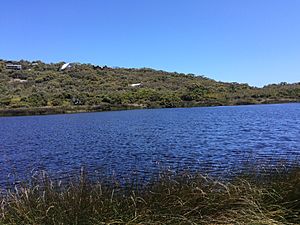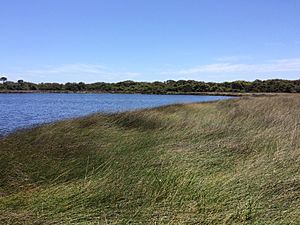Lake Vancouver (Western Australia) facts for kids
Quick facts for kids Lake Vancouver |
|
|---|---|

Lake Vancouver December 2018
|
|
| Location | Great Southern, Western Australia |
| Coordinates | 35°05′04″S 117°56′03″E / 35.08444°S 117.93417°E |
| Type | Marginal Fresh water to Brackish water |
| Primary inflows | Ground water and surface flow |
| Catchment area | 0.5 km2 (0.19 sq mi) |
| Basin countries | Australia |
| Max. length | 210 m (690 ft) |
| Max. width | 125 m (410 ft) |
| Surface area | 19,900 m2 (214,000 sq ft) |
| Shore length1 | 620 m (2,030 ft) |
| Surface elevation | 5 m (16 ft) |
| Islands | none |
| 1 Shore length is not a well-defined measure. | |
Lake Vancouver is a beautiful freshwater lake in Western Australia. It's about 20 kilometers (12 miles) southeast of Albany. The local Noongar people call it Naaranyirrap. This name means "when you cup the water in your hands and you drink it," showing how pure the water is. Lake Vancouver is an important wetland. It helps scientists learn how to protect other wetlands in Western Australia.
Contents
About Lake Vancouver
Lake Vancouver is located near Goode Beach. It is the only source of fresh water on the Vancouver Peninsula. The lake sits about 5 meters (16 feet) above sea level. It gets its water from rain and underground water. About one-third of the land around the lake has been cleared.
The lake formed on the edge of granite rock. It was created as fine clay and silt moved, and the land slowly sank. The lake and its surrounding wetlands get fresh water from rain runoff and underground flows. These wetlands also help refill the underground water supply.
The water in Lake Vancouver has low salt levels. This means it's mostly fresh, but can be a little bit salty.
Why the Lake is Healthy
This wetland is considered very clean and natural. It provides an important water source for animals in the area. The lake is surrounded by private land. Its excellent condition is due to a wide area of natural plants around it. This plant buffer helps keep the lake connected to clean, shallow underground water. The water quality is good, with low levels of nitrogen and phosphorus. However, it is not safe to drink directly. The water levels change with the seasons. They depend on rainfall and how much water is in the ground. The fresh water sits on top of a layer of salt water underground.
Plants Around the Lake
The lake is surrounded by thick plants. This plant area stretches from 10 to 40 meters (33 to 131 feet) from the lake's edge.
- Tall trees: You'll mostly see swamp-loving trees like Banksia littoralis, paperbark Melaleuca cuticularis, wonnich Callistachys lanceolata, and the common peppermint tree Agonis flexuosa.
- Mid-level plants: The woolly bush Adenanthos sericeus makes up most of the plants in the middle layer.
- Ground cover: Close to the ground, you'll find sedges like Lepidosperma gladiatum or Lepidosperma effusum, and rushes like Baumea juncea.
- Other plants: Banksia sessilis (also called budjan) is also found here.
Animals in and Around the Lake
Because the lake has low nutrient levels, it doesn't have a lot of algae. This means it doesn't attract a huge number of waterbirds all the time. You can usually spot musk ducks, and other bird species visit sometimes.
The lake is home to 15 different groups of tiny water creatures called macroinvertebrates. These include:
- Copepoda
- Ostracoda
- Decapoda
- Oligochaeta
- Gastropoda
- Conchostraca
- Corixidae
- Chironomidae
History of Lake Vancouver
The traditional owners of this land are the Mineng group of the Noongar people. They have lived here for about 70,000 years. They call the lake Naaranyirrap. The Noongar people believe that this site is where the Wagyl (a spiritual serpent) comes up for air. They believe the Wagyl creates the underground tunnels through which the water flows.
Both the lake and the land around it are named after George Vancouver. He was an explorer who landed nearby at Point Possession in 1791. He drank from the spring that feeds the lake.
Recent Changes and Development
In 2011, a local group received money to improve access to the lake. They built pathways, boardwalks, and signs to help people learn about the area. They also added a bird hide for watching birds. This work was finished in 2012, and the public was then allowed to visit.
In 2017, plans were made for a new development near the lake. This plan included buildings for visitors, car parking, and places to eat. The City council approved this plan in 2018. Some people were concerned about the impact on the local plants and animals.
- Endangered Species: Some endangered animals have been seen near the lake. These include the Carnaby's black cockatoo and the western subspecies of ringtail possum, called ngwayir. A tiny pygmy sundew plant has also been found here.




